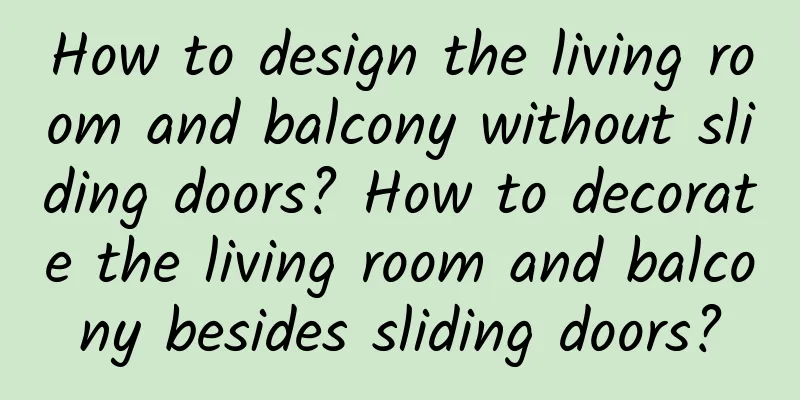How to design the living room and balcony without sliding doors? How to decorate the living room and balcony besides sliding doors?

|
We all know that different houses have different house types, layouts and areas. Most houses have living rooms and balconies connected together, which is quite common. There are many kinds of decoration designs for living rooms and balconies, and many people will make sliding doors. So how to design the living room and balcony without sliding doors? Let's take a closer look! How to decorate the living room and balcony without sliding doorsThe living room is connected to the balcony. In addition to placing a sliding door, how else can it be designed? To put it simply, there are generally three ways to deal with it: install a door, no door, and install half a door. No doorIf there is no balcony door, the design is usually like this: directly remove the balcony door and make the living room and balcony connected as one. What are the benefits of this? The space looks bigger, which greatly increases the usable area of the living room. Firstly, the sense of transparency is stronger. There is nothing blocking the light, so the light is better. From a practical point of view, it reduces a lot of burden for houses with small living rooms. But the biggest drawback is that you can't dry clothes on the balcony, which can usually be solved with a dryer. Door InstallationThe most common method is to install a door. Doors are very useful and generally focus on practicality. Heat preservation and sound insulation. With this door, bad noise and temperature can be isolated outside the balcony. Beautiful and sanitary. Mainly for living balconies. Washing and hanging clothes on the balcony will not affect the beauty of the living room. It also provides privacy for the owners of the lower floors, especially at night. If there is no balcony door, the curtains must be drawn in time. For owners who value practicality, it is recommended that you install balcony doors. Install half doorIn simple terms, if you don't install a balcony door, you can still separate the balcony from the living room, which can ensure the functionality of the balcony. Secondly, from a visual point of view, you can still expand the living room area. It is a compromise between the above two methods. The specific method is to install partitions, which are divided into two types: hard partitions and soft partitions. Hard partitions are generally used less frequently. They are arches and screens installed in special places. This type of partition has a strong ability to block light and people. For example, if you don't want to install a balcony door, you can keep the drying function of the living balcony without hindering the leisure reception in the living room. You can try this method. Soft partitions are generally widely used. This type of soft partition is suitable when the functions of the living room and balcony are relatively small, such as fitness, leisure, etc. The general method is to build a platform on the balcony. Use the top surface shape, and you can also use the color shape of the wall and floor to divide the area. Visually, it is still an integrated space. Design method of connecting living room to balcony1. Open LayoutThe open layout integrates the balcony area into the living room, expands the living room area, eliminates the original balcony space, and presents the living room scenery with a wider field of vision. The first condition is that the wall between the balcony and the living room can be removed and there is no load-bearing structure. It is suitable for small apartments that need to increase lighting, or families with no actual demand for balcony area. 1. Tatami Tatami is a large-scale cushion with a small coffee table in the center, which is used as a tool for communication and drinking tea. Add tatami in the outer area of the living room, with drawers at the bottom for storage and a place for leisure at the top, which combines storage and leisure, and is a design that has the best of both worlds. 2. Study The study room can not only be used for daily office work, but also become a treasure place for reading enthusiasts. However, if the house type does not allow, you can only free up a work area in a wide area. Therefore, the balcony can be turned into a study room or a simple work area, and a simple and comfortable working environment can be created with bookshelves, desks and office chairs. 2. Clever use of partitionsThe purpose of partitions is to make the invisible visible, and to separate two functional areas with simple household items, making the space boundary clearer and more layered. There are many different ways of partitions, and each partition can be reasonably planned according to the characteristics of the house. 1. Glass sliding door Glass sliding doors are a common form of partition. While separating the living room and the balcony area, they will not affect the outdoor light shining into the living room. The transparent glass texture will not block the extension of the living room space. It has the advantages of isolating external noise and heat preservation. More clear and clean decoration and less heavy design are the beautiful demands of contemporary people for their home. 2. Bookshelf Different from the open study room model, the bookshelf stands at the junction of the living room and the balcony, dividing the two with its three-dimensional design, forming a rational layout form, which is simpler and more intuitive. The bookshelf can solve the problem of book storage at home, while giving the living room a bookish atmosphere, forming an exhibition and viewing area. 3. Screen Screens originated in ancient times. They are mostly made of wood on the outside and woven in the middle. The ambiguous style is more beautiful. Generally, screens are placed in a prominent position in the home to play the role of separation, coordination and decoration. Choose a classic and elegant screen for new Chinese style or other home styles, and present it in the interior space with an elegant charm. 4. Bay window design In people's minds, bay windows are areas for relaxation and soothing. People fantasize about enjoying the beautiful sunshine on the bay windows, but in fact, the living room and balcony can also be connected to form a bay window. By using the design of a custom cabinet, a height of 30-50CM is added below to form a "step bay window" style. The cabinet body is used as storage, and cushions and pillows are added above, so that the vision of reading on the bay window can be realized. 5. Curtains Curtains are no longer exclusive to bedrooms, but can also be installed in living rooms. There are two prerequisites for installing curtains. One is that there are door piers on both sides of the balcony, which cannot be removed as they are load-bearing structures. Therefore, curtains are used to block them, weaken the visual difference of the door piers, and beautify the living room environment; the other is to block the strong light from the outside and play a role in heat preservation and insulation. The choice of curtains is also a factor worth considering. If there are sliding doors or hinged doors inside, the curtains can be hung on the outside of the balcony or on the door. Choose cotton, linen or gauze. Light-colored curtains can reduce the impact on indoor light. If it is an integrated layout, the curtains can be installed in the external area, and blinds or rolling shutters are preferred. Common designs for living rooms and balconies1. Design of folding doorUnlike sliding doors, when you want a spacious living room or need a balcony and living room together, folding doors can be well "stored" to achieve the effect you want; if you want to enjoy two spaces, just "close" it to keep the spaces independent. Moreover, folding doors can be "stopped" at any time according to your needs. The different sizes of unfolding or folding can form different degrees of "division" of the two spaces, which is also very interesting! The more exquisite style of folding doors can bring a good decorative effect to the space. 2. Bar designSince the wall between the balcony and the living room is generally thicker, a small bar can be designed at the doorway based on its thickness. The style of the bar depends on the decoration style and personal preference. If the bottom of the bar is "suspended", it will make the permeability between the living room and the balcony better. Because it is located at the doorway, the length of the bar needs to be based on the width of the doorway to avoid the bar being too long and causing inconvenience for people to pass through the doorway; setting a small chandelier above the bar is a good way to set off the atmosphere! 3. Partition designPartitions are set at the doorway between the living room and the balcony. The setting mode of the partitions is combined with the width of the doorway and takes functional requirements as the "starting point". For example, in the picture below, the partitions are set in a "3+1" mode. The three partitions together are used as the boundary of the sofa area, and the other partition is used in conjunction with the three partitions to construct the living room and balcony areas. There are many styles of partitions, and you can choose according to your home decoration style and personal preferences. 4. Storage compartment designDesigning a storage grid between the balcony and the living room not only serves as a "dividing point" but also increases storage space for the family. You can put some ornaments, collections, flowers, etc. to decorate and beautify the space; if the balcony is designed as a small tea room, the storage grid can also be used to place tea sets, tea leaves and other related items, which is convenient to use. I would suggest making the storage compartments "transparent", which will have less impact on the lighting in the living room, but the items placed there are easier to knock over if you're not careful, so please pay attention to safety issues. 5. Design of “half-height” partition wallDesigning a "half-height" partition wall between the living room and the balcony can achieve both functionality and separation purposes, while still maintaining the permeability of the living room and balcony; the style of the "half-height" partition wall should match the decoration style of the space. ⑴Used as a TV wall Setting up a "half-height" TV wall between the living room and the balcony as a partition not only meets the functional requirements, but also achieves the purpose of "partition". The bar design behind the TV wall in the picture below does not take up a lot of space, but it can be used for leisure or as a small desk, increasing the use function of the family. ⑵Used as a sofa back wall When the sofa needs to be placed with its back against the balcony, the "half-height" partition wall designed between the living room and the balcony can be used as the "back wall" of the sofa. The integrated design with the door shape makes the space more integrated and does not make the "back wall" particularly abrupt. ⑶Used as storage space The design of "embedded" cabinets in the "half-height" partition wall is not large in size, but it can be used to store laundry detergent, washing powder and other items that are often used on the balcony. If they are classified and organized, the storage space can still meet basic needs. The style of the cabinet door matches the decoration style and can also add some decorativeness to the space. 6. Design of the modeling doorCombined with the family's decoration style, the doorway is added to the shape, weakening the existence of the doorway, and "transformed" into a decoration of the space, and the matching with the space is no longer rigid. At the same time, the balcony can be better used as an extension area of the living room, strengthening the connection between the two. 7. Don’t design anythingThere is no need to make any design between the balcony and the living room. Just follow the treatment method required by the decoration style, let the living room and balcony "extend" into each other's space, achieve the effect of "expanding" each other's space, and make them better become "one". |
>>: How to design the wall? Classic and durable wall decoration design skills
Recommend
What are the symptoms of female genital herpes
Nowadays, people have become more open to sex as ...
What to do if you have a miscarriage in early pregnancy
People say that the first three months of pregnan...
Why are kiwis available all year round? Should kiwis be kept in the refrigerator in summer?
Kiwi fruit, also known as kiwi fruit, is oval in ...
Can quail eggs and crabs be eaten together? What are the benefits of eating quail eggs and crabs together?
Quail eggs and crabs are both nutritious foods wi...
What causes abdominal pain after menstruation?
Menstruation comes to every female friend every m...
What to do if pregnant women have high white blood cell count
For female friends, pregnancy is a necessary stag...
What is the reason for blood in urine?
Women sometimes find blood after urinating, which...
How to treat bilateral ovarian polycystic changes
The ovaries are one of the female organs unique t...
How to moisturize your vagina
Women should pay attention to the health of their...
Will cervical polyps cause bleeding during intercourse?
Cervical polyps are a major manifestation of chro...
Can I use a pregnancy test 13 days after sex?
For families hoping to have a baby, it is a very ...
What kind of place is Zhangjiajie? What are the intangible cultural heritages of Zhangjiajie?
Zhangjiajie is a haunting place with unique natur...
What to eat for women with Yin deficiency and blood heat
People with Yin deficiency and blood heat constit...









